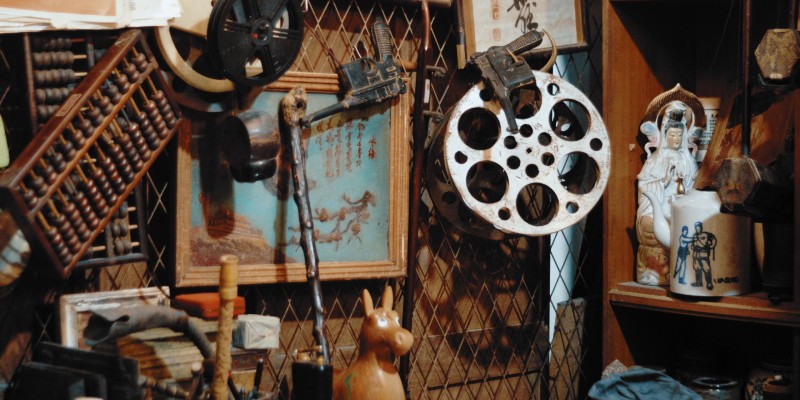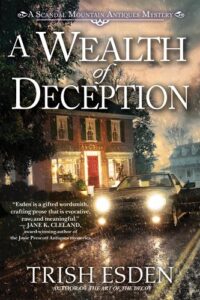It’s summer in New England. The sun is just peeking over the mountains, but cars and trucks are already rolling into the parking lot of the local flea market. The vendors rush to unpack and setup. The first customers hurry down rows of tables and tents, hoping to spot a rare collectable or antique at a low price before other buyers arrive. Many of these customers are antique dealers, others are collectors, some are local homeowners or tourists. Before the morning is done, any or all of them may purchase something they’ll later regret.
My name is Trish Esden. I’m the author of the Scandal Mountain Antiques Mystery series and a full-time antique dealer, a profession I’ve been involved with since my teens. I also spend a great deal of time at country flea markets. And, though I should know better, I have and still occasionally fall for flea market ploys.
What sort of tricks am I talking about? The most common is what I call the ‘good story’. Like mystery authors, flea market vendors know the power of backstory. Sometimes the origin story they provide about a collectable or antique is total fiction. Sometimes it might be an embellished version of the truth. A rusty cast iron skillet becomes a lot more appealing when it was discovered in the summer kitchen of a great-grandmother’s Adirondack camp that was built in the 1890s. Notice, the seller didn’t say the skillet was made in the 1890s. It came out of a camp that was built around that time. The pan might well only be five years old and have become rusty from spending the winter outdoors, but those things aren’t mentioned. In this case, a manufacturer’s mark on the bottom of the pan, or its weight and construction might solve the age question. “How old is it?” a potential customer might ask. “I don’t know much about cast iron,” the flea market vendor could respond. Perhaps the vendor truly doesn’t know the answer or maybe they’re withholding the truth. Either way, the customer has essentially been told ‘buyer beware’. Of course, if the buyer doesn’t care about the skillet’s age or antique value, then there is no reason not to buy it as long as the price is the same or less than what it’s available for elsewhere—such as at Walmart or on Amazon.
There is a vendor at one of my favorite flea markets who deals in unusual pieces. However, every time I express an interest in something he tells the same origin story. The story involves his world-traveling son and a host of other specific details. It’s not a bad tale to add appeal to an object, except it becomes unbelievable when I hear the same story about every item in his booth, week after week. The moral is: don’t base a purchase or an item’s value on the story a vendor tells. Base it on your own experience, research, and personal examination of the piece.
The next category of flea market shenanigans is the ‘sneaky tricks and alterations’. There are lots of ways to make something appear older than it is, like in the case of the rusted skillet. Another simple trick is to remove a mass produced item from its original packaging and present it as if it is used, or better yet antique. Bejeweled hair clips purchased on Amazon can be mistaken for Victorian hair pins when tossed into an old box or beat-up jewelry chest. Unscrupulous vendors are known to make glassware look old by scuffing the bottom of a piece against gravel to create scratches that resemble natural wear. “This piece is very old,” the vendor says. “Look at how worn and scratched the bottom is.” Similarly, modern ‘made in China’ stickers are easily removed. Paint can also be artificially worn and crackled. It’s one thing to buy a distressed piece of furniture knowing that’s what you’re getting. It’s quite another to pay antique value only to discover you’ve been misled.
Flea markets are by nature home to used items. Pieces that are honestly old, may also be damaged. Nicks, chips, cracks, repairs…damage of all sorts won’t necessarily be pointed out or mentioned by the vendor and can be easily overlooked if a buyer rushes instead of thoroughly examining a piece. Don’t feel pressured into instantly buying something. Look it over carefully and in good light. Chips can be disguised by coloring them with paint or markers. Foul smells—yes, don’t forget smell—can make a piece valueless. That pretty antique quilt or seemingly clean stack of linens, once put into your car may reveal themselves to be disgustingly stinky. And I’ll guarantee you, a majority of vendors will be glad to get them off their hands and not as willing to mention the stench ahead of time—or they’ll lie and say something like, “A quick squirt of Febreze or airing out will easily get rid of that smell.”
The last category I’m going to bring up is ‘preconceived ideas’. Flea market vendors come in all shapes, sizes, age groups, and educational backgrounds. They are also generally very astute. They’re more than happy to let you believe you’re outsmarting them while they’re busy pulling the wool over your eyes. Don’t act like a know-it-all. It’s only asking for trouble. I read an article recently that said older flea market vendors are less likely to be active on the internet. Therefore, they are less likely to be aware of current antique and collectable values, and easier for buyers to outsmart. This is total malarky. Yes, there are flea market dealers who prefer to sell in person and for cash and don’t pay any attention to online values. But age isn’t a way to judge this. It also doesn’t mean the vendor isn’t well informed.
In conclusion, there are tons of wonderful deals and items to be discovered at flea markets. Just don’t rush, don’t believe what you’re being told, and if that little voice inside you is whispering a deal is too good to be true, it probably is.
If you enjoy novels featuring small time cons and shenanigans like the ones you can run across at flea markets, there are many books to choose from, classics and recent releases. In my Scandal Mountain Antiques Mystery series, the main character not only buys at flea markets, she’s also been a flea market vendor and is very familiar with tricks of the trade. The Lovejoy Mystery series by Jonathan Gash and the associated TV show are in some ways outdated and may make some modern readers cringe. However, they are ripe with tricks and devious small time antique related swindles. Jane K. Cleland’s Josie Prescott Antiques Mysteries touch on a variety of things buyers need to watch out for. Priceless by Robert K. Wittman is nonfiction about the FBI Art Crime Team. It also includes tidbits which might open a person’s eyes to lesser swindles. TV shows such as Flea Market Flip, Antiques Roadshow, and Pawn Stars on occasion show ways people can be conned.
***


















